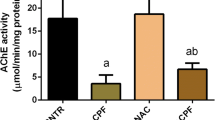Abstract.
Rationale: Multiple low doses of cocaine (COC) may cause intermittent vasoconstriction and reperfusion, leading to elevations in damaging reactive oxygen species, such as hydroxyl free radicals (•OH). Salicylate may offer protection because it reacts with •OH and/or because of its anti-inflammatory actions. Objective: To measure •OH concentrations in hearts and brains of chicken embryos exposed to multiple, small doses of COC, and to determine if otherwise non-toxic doses of sodium salicylate (NaSal) protected against the marginal but significant reduction in hatchability caused by a model of "binge" COC exposure. Methods: Three experiments were carried out. In the first, 67.5 mg COC/kg egg was administered as five doses of 13.5 mg/kg egg or 0.675 mg/egg every 1.5 h, injected just beneath the shell, on day 18 of development (E18), 1 h after NaSal (25 or 100 mg/kg egg) was injected as a bolus. Hearts and brains taken shortly afterward were analyzed for •OH. In experiment 2, the dose of COC was reduced to 56.5 mg/kg egg so as to achieve a small but significant reduction in hatchability in order to determine if NaSal protected against or enhanced COC's toxicity, manifest as an increase or decrease in hatchability. The doses of NaSal for this experiment were 50, 100 or 200 mg/kg egg, all devoid of effects upon hatchability when injected alone. Experiment 3 was done to confirm the presence of vascular disruptions/hemorrhages observed on COC-exposed embryos while harvesting hearts and brains for chemical analyses and to quantify what appeared to be enhanced COC-related vascular accidents associated with NaSal pretreatment. The dose of NaSal used in experiment 3 was 200 mg/kg egg and COC was injected again at 5×13.5 mg/kg egg. Results: COC increased •OH in hearts and brains of chicken embryos on E18, and non-toxic doses of NaSal (i.e. 100 or 200 mg/kg egg) enhanced COC's toxicity in a dose-related manner. The lowest NaSal dose (50 mg/kg egg) may have offered some protection against the effects of COC, as the reduction in hatchability caused by 56.5 mg COC/kg egg was no longer significant. Vascular disruptions/hemorrhages were associated with and most likely responsible for the interactive toxicity. Conclusions: Our unexpected findings may be of clinical relevance because of the use of aspirin for treatment of misdiagnosed "preeclamptic" COC-abusing pregnant women and its possible use for COC abusers at risk for reduced cerebral blood flow and stroke.
Similar content being viewed by others
Author information
Authors and Affiliations
Additional information
Electronic Publication
Rights and permissions
About this article
Cite this article
Castelli, .M., Venturini, .L. & Sparber, .S. Cocaine and salicylate: documentation of hydroxyl radical formation in hearts and brains of 18-day-old chick embryos and unexpected interactive toxicity. Psychopharmacology 156, 23–31 (2001). https://doi.org/10.1007/s002130100726
Received:
Accepted:
Issue Date:
DOI: https://doi.org/10.1007/s002130100726




